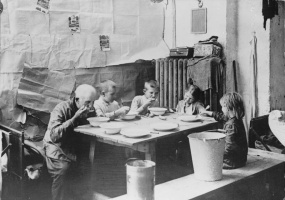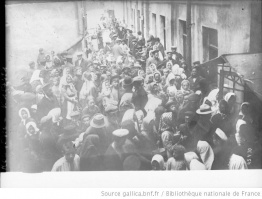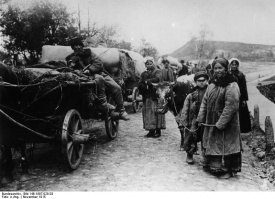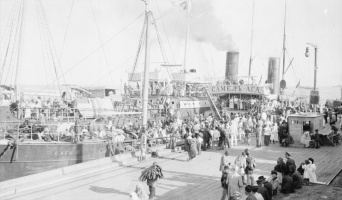Definitions↑
In its broadest sense, the term refugee refers to any member of a civilian population obliged by war, persecution, famine, or other catastrophe to leave his or her home. Official and legal definitions of refugee tend to be narrower, reflecting political considerations such as the application of state obligations and questions of national sovereignty. In a decree of 1915, the tsarist authorities defined refugees within the Russian Empire as "those persons who have abandoned localities threatened or already occupied by the enemy, or who have been evacuated by order of the military or civil authority from the zone of military operations", as well as "emigrants from states hostile to Russia."[1]
Origins of Refugee Movements↑
The Germans advanced into the western borderlands of the Russian empire: into Poland in 1914-1915 and later into Ukraine and the Baltic provinces. Their arrival caused tsarist officials in these regions to abandon their posts and civilians to flee into the interior, in fear of conscription or brutal treatment at the hands of the enemy. The actions of the Russian military authorities also caused the forcible displacement of many of their own citizens. Regulations adopted by Nicholas II, Emperor of Russia (1868–1918) in 1914 subjected most of the empire’s territory west of St. Petersburg, Smolensk, and the Dnieper River to military rule. The military authorities targeted certain groups of civilians, deemed to have doubtful loyalty, for harassment and deportation deep into the Russian interior. This included Jews, gypsies, Poles, and Ukrainians, as well as German subjects of the tsar who had been settled in the Volynia and Volga regions for several generations. The army also pursued a scorched-earth policy that entailed the destruction of entire villages and the indiscriminate forced removal of civilians.
In addition, refugees fled into the Russian Empire from enemy-controlled territory. In 1914 Russia occupied Austrian-ruled Galicia; in 1915 the territory was reconquered by Austrian troops, prompting the movement of refugees across the border. Advance and retreat in the southern borderlands of the empire also created an influx of refugees, as Russian troops crossed into Ottoman-controlled territory in 1915 only to withdraw hastily following a Turkish counteroffensive. In the wake of the Russian retreat, hundreds of thousands of the local Armenian population who were blamed for the earlier defeats of the Ottoman army were arrested and deported to the south or killed. A minority, however, escaped into the Caucasus and Trans-caucasus regions of the Russian Empire.
Official definitions of refugee status by the tsarist authorities stressed the threat of enemy violence or orders by their own military authorities, but, in practice, civilians went on the move for many reasons. Some fled their homes not just for fear of the consequences of enemy occupation, but also to keep contact with relatives in Russian territory, including those serving in the tsarist army. Others, unhappy with the suffering caused by the Russian military’s policy of requisitioning and harassment in the west, left of their own accord to seek better conditions in the east of the country.
Number of Refugees↑
According to some official figures there were 4.9 million refugees in the Russian empire by January 1917. Official records no doubt understate the actual number of refugees. Recent estimates that take into account under-registration by the tsarist authorities put the total number by 1917 at over 6 million. This was in the region of 5 percent of the Russian Empire's total population at the time - a greater proportion than the industrial working class. In certain towns and cities the proportion of refugees among the inhabitants was much higher, as in Samara, where almost 30 percent of the population were refugees by the middle of 1916.
Refugee Experience↑
Suffering↑
Most primary accounts of the refugee experience accessible to scholars come from official observers and relief workers. These people paint a picture of immense human suffering: an exhausted, starving mass of people crowding into Russian villages, towns, and cities; or drifters along the empire’s roads, railways, and river banks who spread the threat of cholera, typhus, and dysentery. Conditions were difficult for those forced out of their homes. They often left on short notice, with just hours to pack the few possessions they could carry and little idea of where they were going. Groups deported for their suspect loyalty, such as Jews and Germans, were loaded in haste into sealed cattle trains and could be left for days to endure thirst, hunger, disease, and extreme temperatures. During the arduous journey from Ottoman territory, as many as one in five Armenians died.
New Approaches↑
Since the 1990s, historians have suggested that the image of the passively suffering or disorderly and diseased refugee reflects concerns of relief workers and officials who saw them as objects of humanitarian relief or a bureaucratic problem. This portrayal does not account for variations in experience and can obscure the voices of refugees themselves. The refugee experience brought not just despair but opportunities. Russian Jews escaped the confinement of the Pale of Settlement, the social structure of estates shifted, and peripheral nationalities gained visibility in the centre of the empire. The experience of being a refugee and working among refugees sometimes generated a new sense of purpose, solidarity, and capacity for action. In this view, refugees were an important social category in the history of the First World War in the Russian Empire, not just in terms of their numbers but also their impact on the social and political order.
Responses to Refugees↑
The tsarist government struggled to orchestrate relief work among refugees. The government delegated much responsibility for the refugee population to municipal authorities, zemstvos, and newly-formed national committees, including Latvian, Armenian, Polish, Jewish, and Lithuanian committees. These committees were able to tie issues of refugee relief to developing notions of national communities among certain groups of the tsar’s subjects.
In August 1915, the tsar approved a Special Council of Refugees, which disbursed funds for relief, oversaw the registration and relocation of refugees, and planned for their return home. The zemstvos did what they could for the refugees arriving in their localities, providing clothing and emergency accommodation in empty bathhouses, factories, monasteries, and more.
Relief work contributed to the burgeoning independent professional ethos among social workers, doctors, lawyers, teachers, and other zemstvo employees. Private Russian charities - such as the semi-official Tatiana Committee, named after one of the Tsar’s daughters - also helped to trace family members and establish schools, orphanages, and other facilities for refugees.
Sources of information about responses to refugees among residents of a particular locality - particularly peasant attitudes - are scarce. Clashes between refugees and settled populations have featured disproportionately, perhaps, in the secondary literature. Refugee histories since the 1990s have suggested that responses were complex and changeable but often took the form of sympathy, hospitality, and improvised assistance. But refugees were not merely the recipients of humanitarian aid; they also deployed their own self-help measures. Some formed their own organisations on nationality-based lines to support welfare efforts and enable the return home.
Refugees after the First World War↑
Following the end of German military occupation of the western borderlands, many refugees - though not all - wished to return to their homes and families in the newly independent lands. Prolonged negotiations and the shocks of the Russian Civil War, Soviet-Polish war, and famine of 1921–1922 complicated the return home and created renewed displacement on the territory of the former Russian empire; people fled areas of fighting, left the starving towns, cities, and famine regions, or emigrated altogether.
Siobhan Peeling, University of Nottingham
Section Editors: Yulia Khmelevskaya; Katja Bruisch; Olga Nikonova; Oksana Nagornaja
Notes
- ↑ Decree cited in Gatrell, Peter: A Whole Empire Walking. Refugees in Russia during World War I, Bloomington 1999, pp.12-13.
Selected Bibliography
- Baron, Nick / Gatrell, Peter (eds.): Homelands. War, population and statehood in Eastern Europe and Russia, 1918-1924, London 2004: Anthem Press.
- Gatrell, Peter: A whole empire walking. Refugees in Russia during World War I, Bloomington 2011: Indiana University Press.
- Kulischer, Eugene Michel: Europe on the move. War and population changes 1917-1947, New York 1948: Columbia University Press.
- Marrus, Michael Robert: The unwanted. European refugees in the twentieth century, New York 1985: Oxford University Press.











